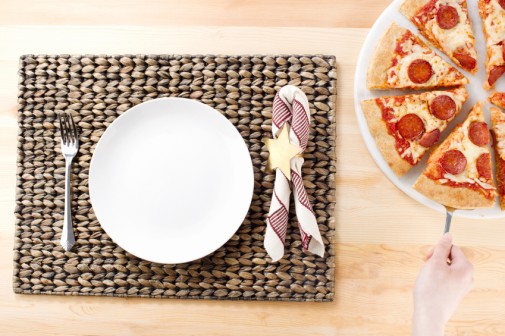Can bigger tables equal smaller meal portions?

As it turns out, size really does matter when it comes to consuming calories.
A team of food scientists from Cornell Food & Brand Lab recently discovered that table and plate size can influence a person’s calorie intake.
“To eat less food, serve food in small portions and on large tables,” lead researcher Brennan Davis, of the Cornell Food & Brand Lab, said in a news release.
Davis and his team studied 219 participants as they ate pizza on different sized tables. Researchers ordered four large, round pizzas and cut them both into regular slices (eighths) and smaller slices (sixteenths). The slices were then divided among the different-sized tables, including small and large.
The participants were each asked to sit at a table and eat as much pizza as they wanted before reporting how they perceived the size of the pizza slices.
The participants who ate the small slices at the small tables ate twice as many slices as those who ate small slices off of the large table. The researchers found that the large table distracted participants by creating an optical illusion. These participants presumed the smaller slices were larger than they really were perceived. Even though this group ate just as many slices as their peers, their overall consumption was lower due to the size of the pizza slices.
Elizabeth Zawila, a registered dietician at Advocate Good Samaritan Hospital’s Health and Wellness Center in Downers Grove, Ill., says the study helps solidify the idea of using a smaller plate in order to eat less.
“Portion control is a really important part of maintaining a healthy diet,” says Zawila. “However, it can be difficult when we are surrounded by large, restaurant-sized portions. We need to retrain our brain in order to get used to normal-sized portions. The good news is that with a little practice, portion control is easy to do.”
Zawila offers the following tips to take control of portion sizes:
- Measure food accurately by using a measuring cup or measuring spoons.
- Learn how to estimate serving sizes when measuring items aren’t easily available. For example, 1 cup is the size of a tennis ball.
- Use smaller plates, bowls and cups.
- Fill half of the plate with fruits and veggies, one quarter with protein and one quarter with a healthy starch.
- Limit liquid calories, which are less filling and tend to be high in sugar.
- When in a situation with many options, pick only a few items instead of small portions of everything. Those small portions tend to add up to more calories.
- Make single-serving portions of pasta, rice, pretzels and other bulk items.
- Avoid trigger foods that prompt overeating.
- Eat without distractions by stepping away from the computer or TV. Instead, be mindful of your meal, eat slowly and savor the flavors.
- When attending parties and potlucks, socialize away from the food.
Related Posts
Comments
About the Author
Johnna Kelly, healthe news contributor, is a manager of public affairs and marketing at Advocate Christ Medical Center in Oak Lawn. She is a former newspaper reporter and spent nearly 10 years as a public relations professional working for state and county government. During her time as a communications staffer for the Illinois General Assembly, she was integral in drafting and passing legislation creating Andrea's Law, the nation's first murderer registry. In her spare time, she volunteers at a local homeless shelter, enjoys traveling, photography and watching the Chicago Bulls.

















